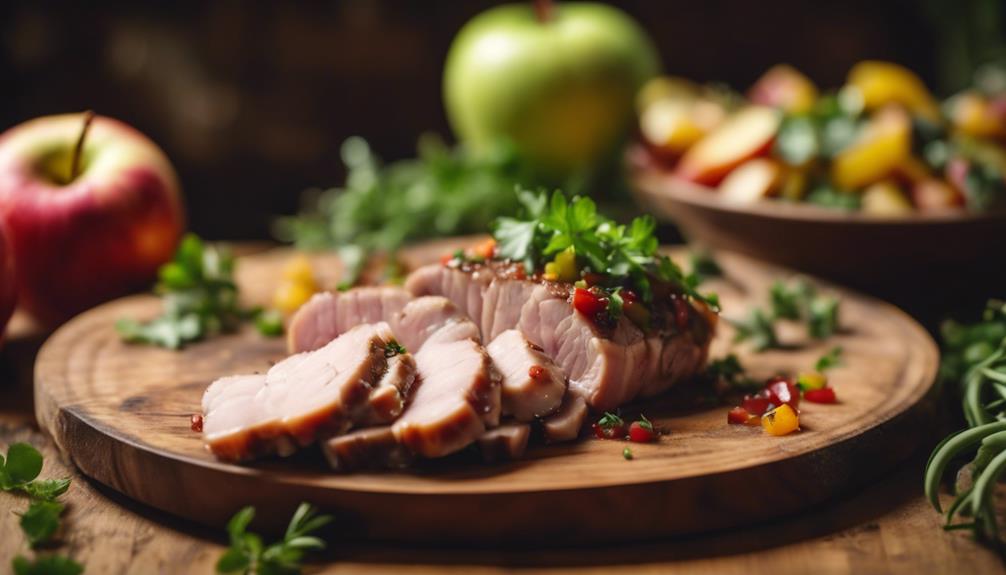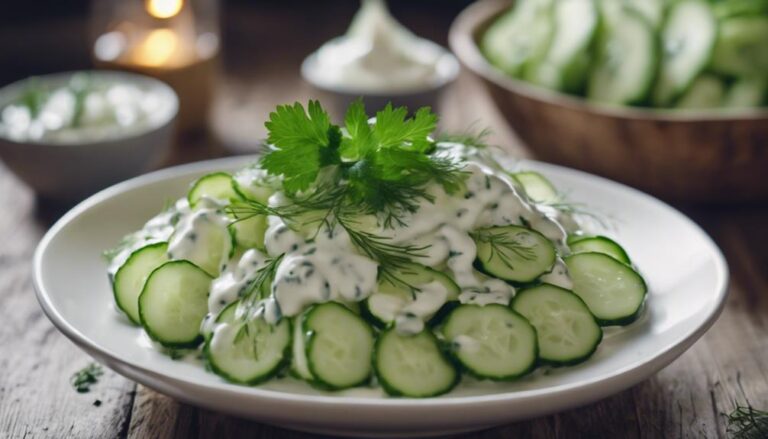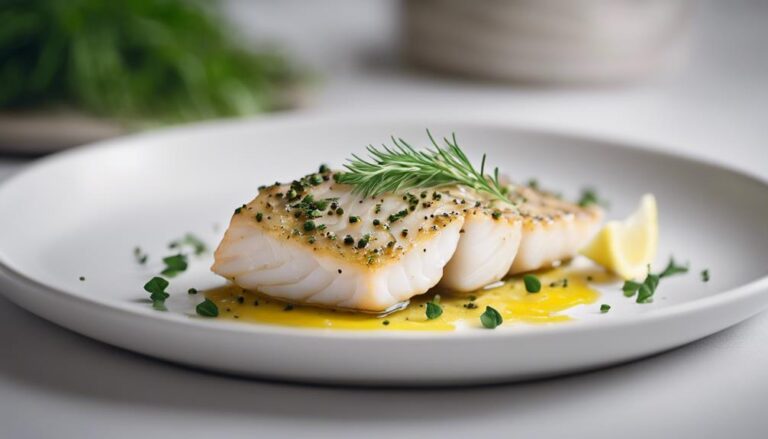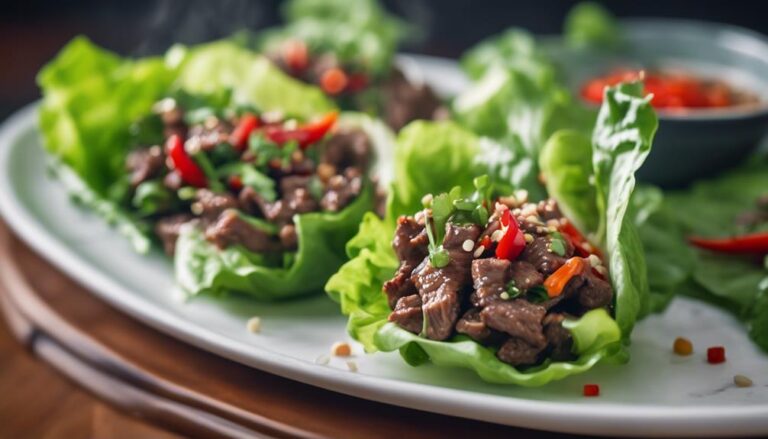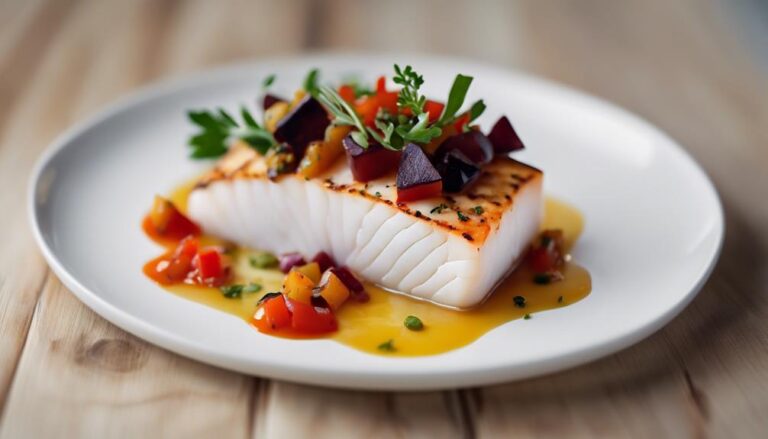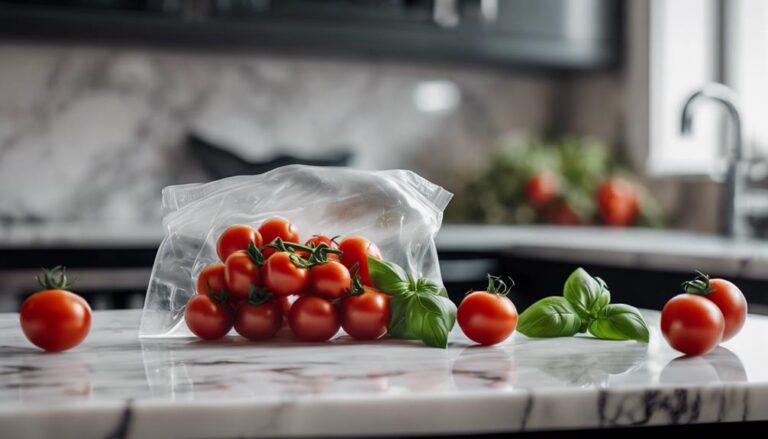Three-Point Sous Vide Pork Tenderloin With Apple Salsa
To prepare your three-point sous vide pork tenderloin, you'll first vacuum-seal the meat seasoned with salt, pepper, and optional aromatics like garlic and thyme. Set your sous vide to precisely 140°F (60°C) to achieve a tender and moist result. After a few hours, remove the pork and quickly sear it in a hot pan to develop a beautifully caramelized crust. Serve it sliced, topped with a vibrant apple salsa made from fresh diced apples, lime juice, chopped cilantro, and a pinch of salt for an invigorating contrast. This combination enhances the pork's flavor and keeps the meal exciting. You might just find some new favorite tips and tricks further on!
What You Will Learn Here
- Sous vide pork tenderloin at 140°F (60°C) to ensure it's tender and moist.
- Vacuum-seal pork with maple syrup and rosemary to infuse flavors.
- Cook pork consistently using precise temperature control for even doneness.
- Prepare apple salsa as a tangy and sweet complement to the pork.
- Finish by searing the pork post-sous vide to create a caramelized crust.
Origins of Sous Vide Cooking
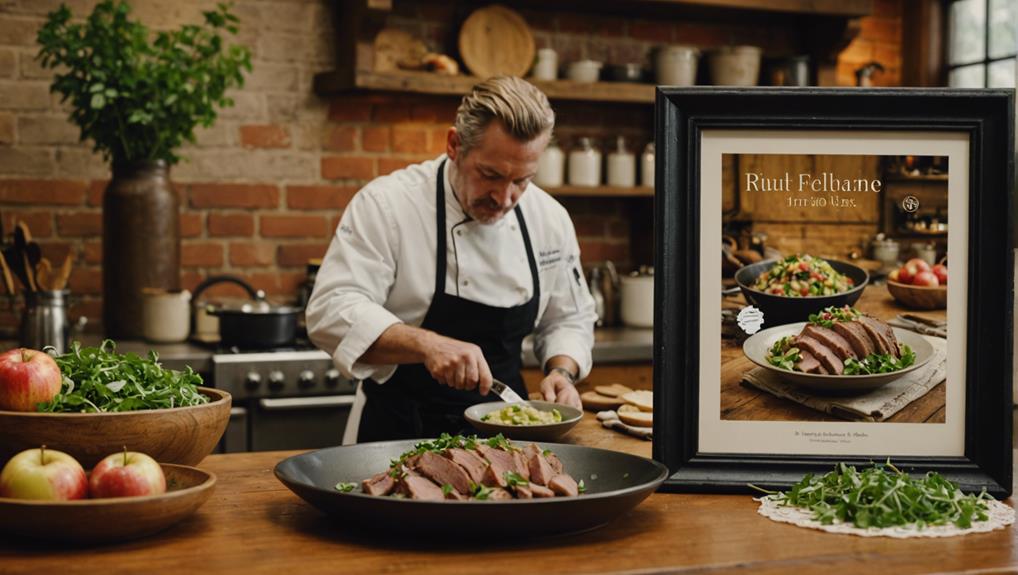
You might be intrigued to learn that the roots of sous vide cooking trace back to 1970s France, where chefs pioneered this technique to lock in flavors and achieve uniform doneness.
This method, translating to 'under vacuum,' involves sealing food in airtight bags and bathing them at precise temperatures, enhancing moisture retention and texture.
Over the years, sous vide hasn't only revolutionized professional kitchens by ensuring consistent culinary masterpieces but has also sparked innovations that now allow you to create such delicacies right in your own kitchen.
Historical Sous Vide Roots
Sous vide cooking, a technique perfected by Chef Georges Pralus in 1970s France, revolutionized how chefs maintain the quality and consistency of delicate dishes like foie gras. By using vacuum-sealed bags, your ingredients are completely enveloped, ensuring flavors are intensified and nutrients remain intact. This method relies on precise temperature control, allowing you to achieve unparalleled consistency across every serving.
Originally a secret of laboratory precision, sous vide evolved into kitchens as a means to ease the culinary process. It promises perfection with minimal effort, freeing you to focus on creative finishes and accompaniments. Embrace this method to guarantee that every dish you serve reaches its highest potential, delighting those you cook for with flawless results every time.
Modern Culinary Adoption
Originating in 1970s France, sous vide cooking quickly captivated professional chefs with its ability to deliver precisely cooked and flavor-enhanced dishes.
As you begin mastering Sous Vide Pork Tenderloin, grasp the importance of vacuum-sealed bags. This vital component ensures that your tenderloin is enveloped in its natural juices, maximizing flavor absorption and retention.
The controlled temperature of the water bath, another cornerstone of this technique, allows for consistent heat distribution. This method guarantees precise results, eliminating the guesswork and inconsistency often associated with traditional cooking methods.
Embrace this modern culinary adoption, where the science of temperature precision meets the art of flavor preservation, making sure that every meal you serve is a tribute to culinary excellence.
Sous Vide Innovations
As we explore the roots of sous vide cooking, remember that this technique wasn't only born from the precision of French kitchens but also from the innovative minds of chefs and scientists like Georges Pralus and Bruno Goussault. They introduced the world to the art of vacuum-sealing ingredients, ensuring flavors are deeply embedded as they cook.
This method, combined with precise temperature control, offers consistent results every time. These chefs transformed kitchens into culinary labs, where technological advancements made it possible to achieve perfection in dishes like your sous vide pork tenderloin.
Today, the sous vide method stands as a tribute to culinary precision, allowing you to serve dishes that are impeccably tender and flavor-rich.
Essential Sous Vide Elements

To achieve perfect pork tenderloin every time, mastering the essential elements of sous vide cooking is fundamental, including precise temperature control and timing. Sous vide allows you to serve up a dish that's not only visually appealing but also packed with flavor and tenderness that your guests will appreciate.
Here are four critical elements to keep in mind:
- Precise Temperature Control: Set your sous vide machine to the exact temperature recommended for pork tenderloin, ensuring it cooks evenly and remains juicy. This method eliminates guesswork and provides consistent results that highlight the quality of the meat.
- Timing is Key: Timing is equally important. Pork tenderloin typically requires about two hours in the sous vide to reach ideal tenderness. This slow cooking process allows the flavors to meld beautifully, ensuring every bite is infused with the intended aromas and tastes.
- Post-Sous Vide Searing: After the pork is cooked, searing it in a hot pan creates a deliciously caramelized crust. This not only adds a textural contrast but also intensifies the meat's flavor, making for an irresistible combination with the apple salsa.
- Balancing with Apple Salsa: The sweet and tangy profile of apple salsa complements the savory, juicy pork exquisitely. It's important to prepare it fresh to maintain the vibrant flavors that will elevate the overall dish, offering a delightful contrast to the richness of the pork.
Trending Sous Vide Dishes
As you explore the latest trends in sous vide cooking, you'll find that dishes like the apple-infused pork tenderloin stand out, marrying the subtle sweetness of apples with the succulence of perfectly cooked pork.
Or perhaps you're tempted by the BBQ bacon-wrapped pork tenderloin, where the smoky bacon intensifies the pork's rich flavors, all enhanced by the even cooking sous vide offers.
Don't overlook the adobo sauce pork tenderloin either; its robust, tangy sauce infuses the tender meat with deep, complex flavors that are hard to achieve through any other cooking method.
Apple-Infused Pork Tenderloin Recipe
Discover the delightful fusion of sweet and savory with our trending sous vide apple-infused pork tenderloin, where maple syrup and rosemary perfectly enhance the tender meat. This dish not only pleases the palate but also presents a beautiful centerpiece for your next gathering.
Here's how you can create this exquisite dish:
- Sous Vide Pork Tenderloin: Cook the pork tenderloin at 140°F for 2 hours to achieve perfect tenderness.
- Searing: Post-sous vide, sear the pork in a hot pan to develop a deliciously crispy exterior.
- Maple Syrup and Rosemary: Baste with maple syrup and rosemary during searing for rich, layered flavors.
- Caramelized Apples: Sauté apples in the same pan to absorb the aromatic cooking juices, complementing the pork exquisitely.
BBQ Bacon-Wrapped Pork Tenderloin Recipe
Wrapping your pork tenderloin in bacon infuses it with a smoky richness, perfectly complemented by the sous vide method to keep the meat juicy and flavorful. This BBQ Bacon-Wrapped Pork Tenderloin Recipe elevates a classic dish with a delightful twist, sure to impress your guests.
Here's how to create this succulent dish:
- Prepare the Pork: Wrap the juicy pork tenderloin in strips of bacon, securing with toothpicks.
- Sous Vide: Cook sous vide at 145°F for 2 hours to guarantee even, tender results.
- Add BBQ Sauce: Generously brush with your favorite BBQ sauce for that perfect glaze.
- Broil: Finish under a broiler for a crispy, caramelized exterior.
Serve this bacon-wrapped masterpiece with pride, knowing every bite offers a burst of flavors!
Adobo Sauce Pork Tenderloin Recipe
Immerse your pork tenderloin in a vibrant adobo sauce, meticulously crafted with vinegar, garlic, and a blend of spices, to achieve a succulent and flavor-packed entrée using the sous vide method. Here's how to make your guests rave about your culinary skills:
- Marinate: Soak the pork tenderloin in adobo sauce overnight to infuse deep, robust flavors.
- Sous Vide Cooking: Seal the marinated pork in a vacuum bag and cook at 145°F for 2 hours, ensuring even, precise cooking.
- Sear: Quickly sear the cooked tenderloin to add a deliciously crisp exterior.
- Serve: Top with a tangy apple salsa for a delightful contrast that complements the savory adobo marinade.
This dish not only satisfies taste buds but also showcases your dedication to serving outstanding meals.
Sous Vide Technique Enhancements
As you explore the sous vide method for cooking pork tenderloin, understanding key cooking temperatures is essential for achieving that buttery, melt-in-your-mouth texture.
Managing your cooking time efficiently guarantees that every ounce of flavor is perfectly captured within the meat, enhancing the succulence.
Pairing the tenderloin with complementary flavors, such as the fresh zest of apple salsa, can elevate the dish to new culinary heights, revealing hidden dimensions of taste.
Optimal Cooking Temperatures
To achieve the most tender and moist pork tenderloin, sous vide cooking at 140°F (60°C) is recommended. This precise cooking temperature allows the pork to retain maximum moisture, ensuring each slice is succulently juicy.
Lower temperature settings in sous vide can enhance the tenderness even further, but always balance it with your desired level of doneness. Conversely, setting the temperature higher risks drying out the tenderloin, compromising both texture and flavor.
Time Management Tips
When managing your kitchen time efficiently, sous vide cooking stands out by allowing you to precisely control cooking times, ensuring your pork tenderloin remains succulent and perfectly cooked without constant supervision.
This technique is a game-changer for time management, maintaining a consistent temperature that guarantees your pork tenderloin won't overcook while you attend to other tasks. You can even prepare multiple dishes at once, each at their ideal temperature.
This not only streamlines your cooking process but also frees up time—no need for minute-by-minute checks. Just set your sous vide, and while it does the work, you're free to focus on crafting other components of your meal or simply relaxing until it's time to sear and serve.
Flavor Pairing Secrets
Exploring flavor pairings in sous vide cooking can greatly enhance your dishes, as demonstrated by the delightful combination of pork tenderloin and apple salsa. By using the sous vide method, you're ensuring that the pork tenderloin retains its natural flavors, juiciness, and tenderness.
The addition of apple salsa, with its invigorating mix of acidity and sweetness, complements the savory richness of the pork beautifully. Infusing the pork with maple syrup and rosemary during the sous vide process adds an extra layer of depth and complexity.
Don't forget to sear the pork post-sous vide; this essential step creates a caramelized crust that contrasts wonderfully with the soft, succulent interior, elevating the overall sensory experience of your meal.
Final Thoughts
With sous vide pork tenderloin, you achieve perfect tenderness every time, and pairing it with the crisp, sweet apple salsa elevates this dish to an exquisite level of flavor. This Sous Vide Pork Tenderloin Recipe leverages precise temperature control, guaranteeing that the pork is succulently soft without any guesswork. While the sous vide method does its magic, you can focus on crafting the vibrant apple salsa, a medley of fresh apples, tangy lime juice, and a hint of cilantro.
When you've achieved the desired doneness of the pork, searing it adds a beautifully caramelized crust that contrasts delightfully with the juicy interior. This step transforms the pork from simply cooked to restaurant-quality, inviting a depth of flavor that's visually appealing as well. The apple salsa, with its invigorating crunch and bursts of sweetness, complements the richness of the meat, providing a balanced mouthfeel with every bite.
Moreover, the addition of maple syrup to the pork marinade intertwines with the natural sweetness of the apples, enhancing the overall harmony of flavors. This thoughtful detail ensures that each component of the dish contributes to a cohesive and memorable dining experience.
As you serve this meal, you're not just offering food, but an artfully balanced blend of textures and tastes that will delight and satisfy. Whether for a special occasion or a deserving everyday meal, this dish stands out as a confirmation of your dedication to serving the best. With every slice of tender pork and spoonful of apple salsa, you're sharing a story of flavor, precision, and passion.
Frequently Asked Questions
Do You Sear Pork Tenderloin Before or After Sous Vide?
You can sear pork tenderloin either before or after sous vide to enhance flavor, develop a crust, and retain moisture. Both methods offer benefits, so choose based on your preferred cooking outcome.
What Is the Best Temperature to Sous Vide Pork?
For the best sous vide pork, aim for 140°F for maximum tenderness and flavor impact. This temperature guarantees food safety, allows for precise cooking with your equipment, and accommodates various recipe variations.
How Long Can Pork Loin Stay in Sous Vide?
You can safely keep your pork loin in a sous vide for up to 4 hours. Longer periods risk a mushy texture, compromising both flavor and quality. Always adhere to recommended temperature guidelines.
How Long Does It Take to Sous Vide Tenderloin?
To sous vide tenderloin, it typically takes 1.5 to 4 hours. Make sure your equipment's set up, the meat's vacuum sealed, and properly seasoned. Always consider safety and avoid overcooking for best flavor.
Conclusion
As you finish savoring your sous vide pork tenderloin, the precision of temperature control and the slow cooking method have worked wonders. The pork is unimaginably tender, each bite infused with the mellow sweetness of perfectly cooked apple salsa.
This dish not only showcases the finesse of sous vide cooking but also elevates a simple meal into a gourmet experience. It's a demonstration of how modern techniques can enhance the natural flavors of basic ingredients to create a sublime culinary creation.
